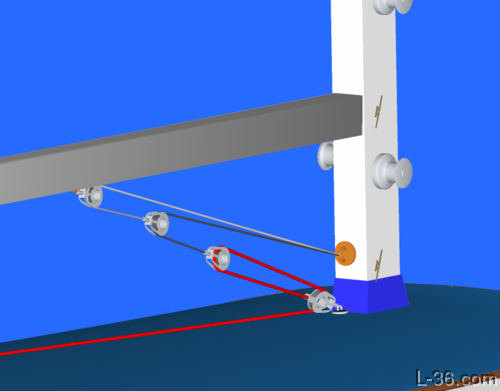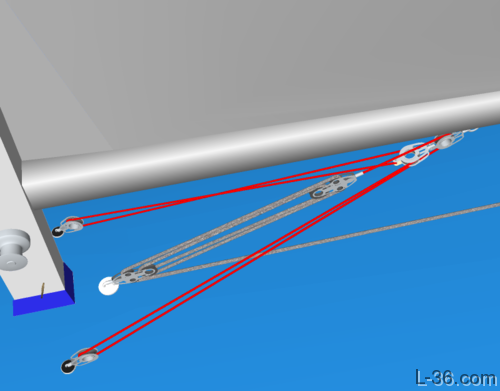8:1 and 20:1 Cascaded Boom Vang
By Allen Edwards
8:1 Cascade Vang System

Cheaper than using two fiddle blocks, lighter, and stronger. What is not to like? You just run the control line back to the cockpit where you put a cam cleat. You will likely need a turning block on deck but then you have the vang where you want it when it needs to be released quickly before you round up.
An intriguing variation is to use $5 repel rings from REI and Amsteel. It takes about 15 pounds pull to get 10 pounds on the other side of the ring. But that is giving you 25 pounds pull on the ring instead of 30 so the loss isn't as great as you might think. For every ring you use instead of a block, multiply the theoretical purchase by 80% to account for the frictional loss. This 8:1 system would be 6.5:1 with a ring instead of the top block. Even lighter, almost as much leverage, and very strong as those rings are rated at 5,000 pounds.
You could use 2 rings and have a 5:1 system, more than the typical 4:1 that so many people have, at a fraction of the cost. The remain two blocks are now only taking a fraction of the load so they can be very small and light.
If using all blocks, each block down the line needs to take 1/2 the load of the one above it, except both blocks with the red line have the same load. You cannot use rings for the red line as that can't be Amsteel because you can't lock it in a cleat and anything that locks in a cleat has just way too much friction through a ring.
As a final note, you can use two fiddle blocks and get a 16:1 if you want a lot of purchase. The upper two single blocks stay the same. For a 16:1 system, the math would be 2 x 2 x 4 = 16.
20:1 Cascade Vang System on Papoose

16 More Vang Systems
Follow THIS LINK for more vang systems.
NOTICE: Some pages have affiliate links to Amazon. As an Amazon Associate, I earn from qualifying purchases. Please read website Cookie, Privacy, and Disclamers by clicking HERE. To contact me click HERE. For my YouTube page click HERE